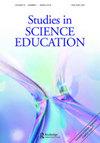空间思维在天文学学习进程中的作用
IF 9.9
2区 教育学
Q1 EDUCATION & EDUCATIONAL RESEARCH
引用次数: 79
摘要
天体运动的伟大思想,用太阳系内外天体的相对位置和运动来解释观测天文现象,是小学和中学天文学教育的核心。在本文中,我认为,学生在对这类天文现象进行富有成效的科学解释方面的进步,可以通过空间知识和领域推理的日益复杂来定义。根据有关儿童天体运动观念的文献、支持该领域进步的教学和空间思维的文献,我开发了一个学习进展(LP)框架,该框架将认知、教学和评估整合在一起,以了解学生在该领域的学习。这个框架被应用于一项儿童学习解释太阳、月亮和星星的日常天体运动以及月亮的相位的研究。LP框架在天文学教学序列分析中的应用扩展了这一综述,说明了这些现象中的进展是如何由学生在运动参照系中可视化物体外观及其运动的能力所塑造的。本文章由计算机程序翻译,如有差异,请以英文原文为准。
Spatial thinking as the dimension of progress in an astronomy learning progression
The big idea of celestial motion, observational astronomy phenomena explained by the relative position and motion of objects in the solar system and beyond, is central to astronomy in primary and secondary education. In this paper, I argue that students’ progress in developing productive, scientific explanations for this class of astronomical phenomena can be defined by the increasing sophistication of spatial knowledge and reasoning in the domain. Drawing upon literature on children’s ideas about celestial motion, instruction that supports progress in that domain and literature on spatial thinking, I developed a learning progression (LP) framework that integrates cognition, instruction and assessment to understand student learning in this domain. This framework was applied to a study of children learning to explain the daily celestial motion of the Sun, Moon and stars, and the phases of the Moon. The application of the LP framework to analyse teaching sequences in astronomy extends this review by illustrating how progress within these phenomena is shaped by students’ ability to visualise the appearance of objects and their motions across moving frames of reference.
求助全文
通过发布文献求助,成功后即可免费获取论文全文。
去求助
来源期刊

Studies in Science Education
EDUCATION, SCIENTIFIC DISCIPLINES-
CiteScore
15.30
自引率
2.00%
发文量
7
审稿时长
>12 weeks
期刊介绍:
The central aim of Studies in Science Education is to publish review articles of the highest quality which provide analytical syntheses of research into key topics and issues in science education. In addressing this aim, the Editor and Editorial Advisory Board, are guided by a commitment to:
maintaining and developing the highest standards of scholarship associated with the journal;
publishing articles from as wide a range of authors as possible, in relation both to professional background and country of origin;
publishing articles which serve both to consolidate and reflect upon existing fields of study and to promote new areas for research activity.
Studies in Science Education will be of interest to all those involved in science education including: science education researchers, doctoral and masters students; science teachers at elementary, high school and university levels; science education policy makers; science education curriculum developers and text book writers.
Articles featured in Studies in Science Education have been made available either following invitation from the Editor or through potential contributors offering pieces. Given the substantial nature of the review articles, the Editor is willing to give informal feedback on the suitability of proposals though all contributions, whether invited or not, are subject to full peer review. A limited number of books of special interest and concern to those involved in science education are normally reviewed in each volume.
 求助内容:
求助内容: 应助结果提醒方式:
应助结果提醒方式:


